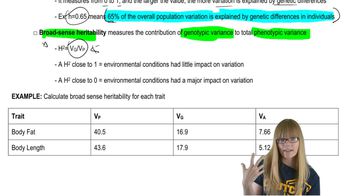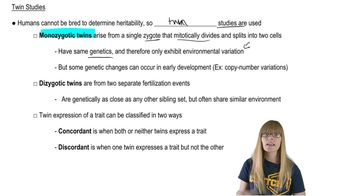Table of contents
- 1. Introduction to Genetics51m
- 2. Mendel's Laws of Inheritance3h 37m
- 3. Extensions to Mendelian Inheritance2h 41m
- 4. Genetic Mapping and Linkage2h 28m
- 5. Genetics of Bacteria and Viruses1h 21m
- 6. Chromosomal Variation1h 48m
- 7. DNA and Chromosome Structure56m
- 8. DNA Replication1h 10m
- 9. Mitosis and Meiosis1h 34m
- 10. Transcription1h 0m
- 11. Translation58m
- 12. Gene Regulation in Prokaryotes1h 19m
- 13. Gene Regulation in Eukaryotes44m
- 14. Genetic Control of Development44m
- 15. Genomes and Genomics1h 50m
- 16. Transposable Elements47m
- 17. Mutation, Repair, and Recombination1h 6m
- 18. Molecular Genetic Tools19m
- 19. Cancer Genetics29m
- 20. Quantitative Genetics1h 26m
- 21. Population Genetics50m
- 22. Evolutionary Genetics29m
20. Quantitative Genetics
Heritability
Problem 11b
Textbook Question
In selective breeding experiments, it is frequently observed that the strains respond to artificial selection for many generations, with the selected phenotype changing in the desired direction. Often, however, the response to artificial selection reaches a plateau after many generations, and the phenotype no longer changes as it did in past generations. Once a plateau has been reached, is the heritability of the trait very high or is it very low? Explain.
 Verified step by step guidance
Verified step by step guidance1
Understand that heritability is a measure of how much of the variation in a trait is due to genetic factors as opposed to environmental factors.
Recognize that when a trait reaches a plateau in response to artificial selection, it indicates that the genetic variation for that trait has been exhausted.
Realize that with little to no genetic variation left, the heritability of the trait becomes very low because there are no more genetic differences to select for.
Consider that at the plateau, any further changes in the phenotype would likely be due to environmental factors rather than genetic factors.
Conclude that the low heritability at the plateau means that the trait is no longer responding to selection because the genetic potential has been fully utilized.
Recommended similar problem, with video answer:
 Verified Solution
Verified SolutionThis video solution was recommended by our tutors as helpful for the problem above
Video duration:
1mPlay a video:
Was this helpful?
Key Concepts
Here are the essential concepts you must grasp in order to answer the question correctly.
Heritability
Heritability is a measure of how much of the variation in a trait can be attributed to genetic differences among individuals in a population. It is expressed as a value between 0 and 1, where a higher heritability indicates that genetics play a larger role in the trait's expression. In the context of selective breeding, high heritability suggests that the trait can be reliably passed on to future generations, while low heritability indicates that environmental factors may have a greater influence.
Recommended video:
Guided course

Calculating Heritability
Response to Selection
The response to selection refers to the change in the average phenotype of a trait in a population as a result of selective breeding. Initially, when a trait is under strong selection pressure, significant changes can occur. However, as breeding continues, the rate of change often slows and may plateau, indicating that the population has reached a limit in the trait's expression due to genetic constraints or reduced genetic variation.
Recommended video:
Guided course

Artificial Selection
Genetic Variation
Genetic variation is the diversity in gene frequencies within a population, which is essential for evolution and selective breeding. When a population has high genetic variation, there are more alleles available for selection, allowing for continued improvement of traits. Conversely, if a plateau is reached in selective breeding, it often signifies that genetic variation for the trait has been exhausted, leading to a low heritability and limited potential for further change.
Recommended video:
Guided course

Genomic Variation

 7:04m
7:04mWatch next
Master Calculating Heritability with a bite sized video explanation from Kylia Goodner
Start learning

